Claussen Pickles are kosher dill pickles at their crunchiest, saltiest best! These homemade Claussen pickles taste like the commercial ones you find at the store, but better. And better yet, they’re ridiculously easy to make!
Whether you’re new to pickle making or a pickle veteran, you NEED to make these half sour pickles! And wonder of wonders, you don’t need to know how to can to make these super fresh, crunchy pickles! Claussen dill pickles are meant to be eaten fresh.
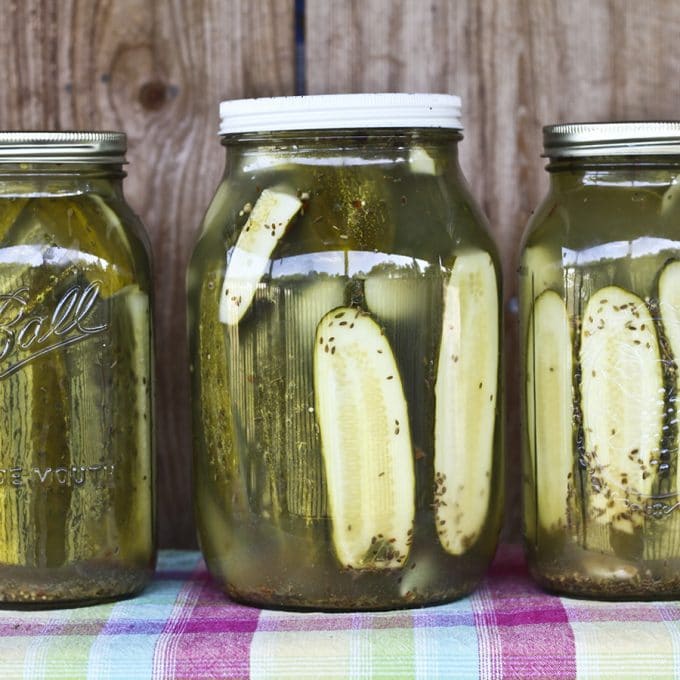
Homemade Claussen Knock-Off Pickles: Always crunchy and garlicky, this perfect homemade pickle recipe requires no special equipment, & no canning experience.
It’s common knowledge that I have a salty tooth rather than a sweet tooth. When the weather does what it has been doing lately (making us all do our best Shadrach, Meshach and Abednego impersonations) I can’t think of a single thing I find more refreshing than an icy-cold, salty, crunchy pickle.
It’s not just me, it’s my whole family: mother, sisters, brothers, cousins, aunts, grandparents, kids, husband… I married a man who loves pickles so much he eats the pickles and then drinks the juice from the jar.
I grew up eating my Grandma’s homemade dill pickles like the supply was endless and moved on to canning my own pickles as soon as I had a kitchen of my own. There’s just something about a homemade dill pickle that makes me happier than any pickled cucumber ever should.
My little sister, Jessamine, and I compare our homemade pickles from year to year the way some people compare wine vintages.
Dill Pickle Recipe
But there is one pickle that stands head-and-shoulders (were pickles to *have* heads and shoulders) above all others. I’m talking about the pickles you see here. That’s right: Homemade Claussen Dill Pickles.
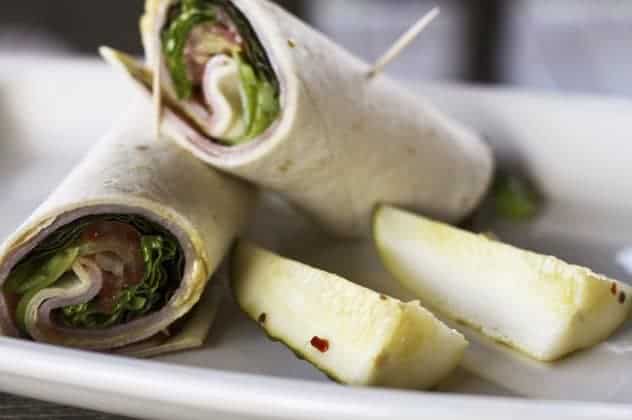
Recipe for Claussen Pickles
What do you need in order to make this recipe for Claussen Half Sour Pickles at home? Let’s get a quick list for both ingredients and equipment out of the way, shall we?
Equipment for Making Claussen Pickles at Home
- A Glass gallon jar or 4 glass quart jars or other food safe container with a tight fitting lid
- Measuring cup
- Chef’s knife or paring knife
Ingredients for Making Homemade Claussen Pickles Copycat
- Small to medium size pickling cucumbers (check your local farm stand or farmer’s market!)
- Apple Cider Vinegar (don’t fret- it doesn’t taste like apple cider and isn’t even a little sweet!) or white vinegar
- Kosher Salt
- Garlic
- Dill (either fresh or dill seed)
- Pickling spices (available here)
A quite note on your vinegar choice: I opt for apple cider vinegar because it’s a smoother vinegar than white vinegar. It does not impart any sweetness or apple taste to the pickles whatsoever.
If you can’t find it (pssst. It’s right next to white vinegar in even moderately stocked grocery stores) or don’t feel like buying it, you can most certainly substitute white vinegar. It’ll just taste a little sharper. (And technically store bought Claussen pickles have white vinegar, so you do you!)
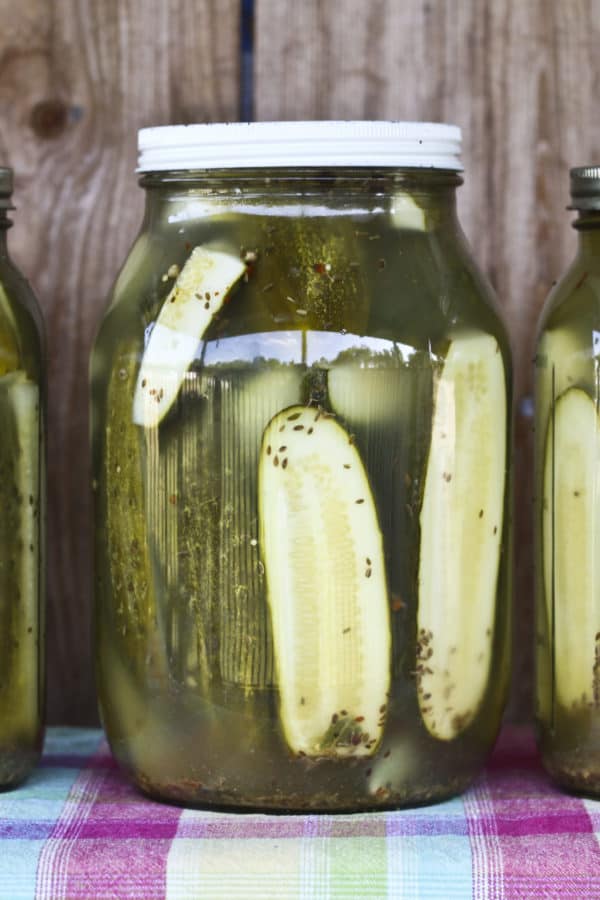
And ya’ll. These homemade half sour pickles are so easy to make it’s almost criminal.
The hardest part is the 2 to 4 day wait for them to be done. Truth be told, though, I’ve snacked on them the day after I made them and been a very happy camper.
Claussen Pickle Recipe
These are homemade refrigerated deli pickles, also known as Lithuanian half-sours, also known (in the commercial equivalent) as Claussen dill kosher pickles, also known as the best pickles ever known to mankind.
Here’s the thing. While I do love my other homemade pickles dearly (otherwise why would I continue canning ninety-something quarts year after year after year), these are by far my all-time favourites.
CRUNCH. That’s what you hear when you bite these. There is no flop, no squish, no soft pickles. These things almost bite back.
This also happens to be the perfect dill pickle recipe for beginning pickle makers. If you’re not into canning, these refrigerator pickles are a godsend. Even if you ARE canning obsessed, like yours truly, this Claussen pickle recipe should be in your pickle repertoire too.
Please note that this Claussen pickle recipe is not suitable for canning. The brine is fermented and not very acidic, which means it has far too high a PH to can safely. If you’re looking for a great canned dill pickle recipe, try this home canned garlic dill pickle recipe.
Refrigerator Pickles
Here’s where we get into the best part of this pickle recipe (aside from the crunch and flavor). You don’t have to cook anything to make these pickles; not one single thing. The brine is stirred together, the cucumbers are rinsed, trimmed and stuffed into a jar with garlic cloves and spices.
These half sour pickles are NOT CANNED. They are simply put into jars. Amen!
When it’s summer time and the idea of turning on the stove makes me want to crawl into an (air conditioned) hole, these pickles are a welcome treat. Not only is that cold crunchy refrigerator pickle waiting to cool me off at the end of the prep time, but I don’t have to heat up my kitchen by even one single degree to get there.
Remember that pickling isn’t just for cucumbers, either! Try out our Pickled Brussels Sprouts, Quick Pickled Red Onions, and famous Candied Jalapenos!
How to Make Pickles FAQ
Please, please, please give these a go even if you have never made a pickle before. There is nothing scary or intimidating here. Wash, slice, stuff, stir, pour, sit, wait.
- Trim 1/8-inch from the blossom end of each cucumber and slice them in half lengthwise or into quarters. The size you choose depends on how large your cucumbers are and how big you want the pickles to be when they’re done. This helps minimize the chances of soft pickles.
- In a gallon jar (or large, wide-mouth, food-safe container) layer the dill heads or seed, pickling spice or mustard seed, and garlic cloves and sliced cucumbers. If you’re dividing the cucumbers up between smaller containers, just divide the garlic and spices evenly between the containers, too.
- Stir your brine together in a separate container. You WILL have more brine than you have space for in the jars, but that’s why you pack the spices in the jars. Just store extra brine in a jar in the refrigerator and use it to top off your pickles if the brine starts evaporating.
- Pour the brine over the cucumbers, taking care to make sure all of them are fully submerged. If needed, place a plate or mug or other ziploc bagged can of beans on the cucumbers to weigh them down and keep them under the brine!
- Cover the jars lightly not tightly and leave out of direct sunlight on the counter for two to four days or until the pickles are picklicious.
- If your kitchen is pretty hot or humid, you can stash them directly in the refrigerator. They’ll just take a couple of days longer to get fabulous. Your patience will be rewarded.
On the plus side, the wait is only two to four days which is significantly less than the six week wait of the canned pickles. Besides, as I said, there is the crunch factor
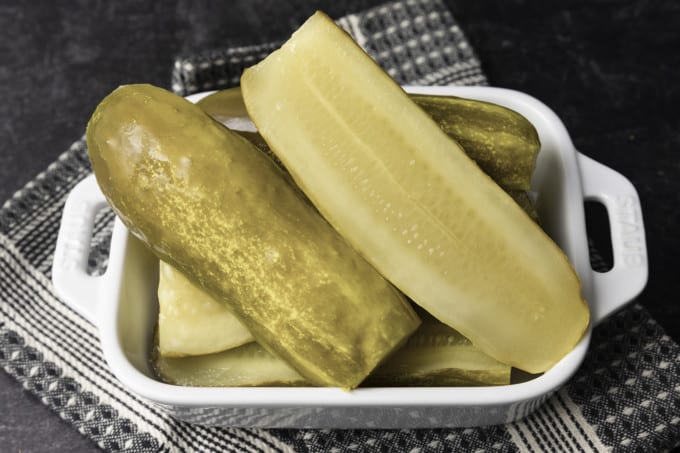
Troubleshooting Your Homemade Claussen Pickles
These pickles are easy peasy to make, but there still may be a couple of things that pop up from time to time that make you go “Hmmm…” In no particular order, here are some of the most commonly asked questions about them and some answers!
- Why is my pickle brine cloudy? Okay, I lied. This is the most common question and that’s because the brine becomes cloudy naturally as a consequence of fermentation (which is what’s happening here.) No worries.
It’s all natural. This half sour pickle recipe (more on this to come) is a fermented pickle recipe and that just happens.
Another possible cause of intense cloudiness or discolouration in your brine is using table salt. The iodine in table salt can also give off flavours to your pickles, so it’s best to stick with kosher salt or pickling salt for these bad boys! - Is the scum, foam, or film on top of my pickle brine dangerous? It’s that pesky (and delicious) fermentation again! This is another thing you don’t have to worry about.
Just scrape it off with a spoon, discard, and top off with a little of that extra brine you whipped up. (See the recipe card for details.) But do remove the scum or it could cause your pickles to go bad. - My pickles went soft! How do I prevent this? This particular tragedy could have two causes.
First, you may have failed to remove enough of the blossom end of the cucumber. There is a naturally occurring enzyme in the blossom end of cucumbers that causes pickles to break down and become soft if it is not removed. Next time, just slice more off.
Second, you may have started with less than spectacularly fresh cucumbers. An older cucumber has had longer for the aforementioned enzyme to kick in, and it has already started its work.
The best solution for this issue is to use cucumbers that have either been picked fresh that day or have been refrigerated steadily since very shortly after being picked a couple of days previously. - Why did my pickles go bad? See that second reason in the “why did my pickles go soft” bullet point? That’s one culprit.
Other potential causes of spoiled pickles are using unwashed cucumbers or fresh dill, old or decayed garlic, bad spices, lower-than-5%-acidity-vinegar, failing to remove the scum from the brine or to keep the pickles submerged in the brine, or storing your pickles in warmer conditions. When in doubt, stash them in the refrigerator! - Why is there mold on my pickles? First, you have my condolences. Second, it’s because your pickles didn’t stay submerged in the brine. That brine has enough salt and acid to prevent mold growth if the cucumbers stay under the surface.
If you’re having trouble finding something that fits in the jar to keep this from happening, try popping a can or two of tomato paste or canned beans in a zipper top bag and gently inserting that into the jar. It should weigh it down enough to do the job. - Should I worry about the white sediment in my jar? This is another one in the “don’t sweat it” category. There are two potential reasons and both are completely harmless.
It’s either a natural consequence of the fermentation or anti-caking agents in the salt. Neither harms the pickles or effects the flavour, so don’t worry! - Why is my garlic blue/green/purple? As long you inspect the garlic before it goes into your jars and it is fresh as a daisy, you have nothing to worry about. It could be the type of salt you used or it could be the variety of garlic. Some types of garlic have a natural propensity to change pretty colours in vinegar.
It also may mean that your pickles were exposed to light. When garlic is exposed to light, it starts producing chlorophyll which is green. It also may indicate that your garlic is more mature.
In that case it is caused by sulfur compounds that naturally occur in more mature garlic reacting with minute traces of copper in the vinegar., but as long as there are no other signs of spoilage (soft or squishy texture, funky smell, discoloured spots), you’re good to go.
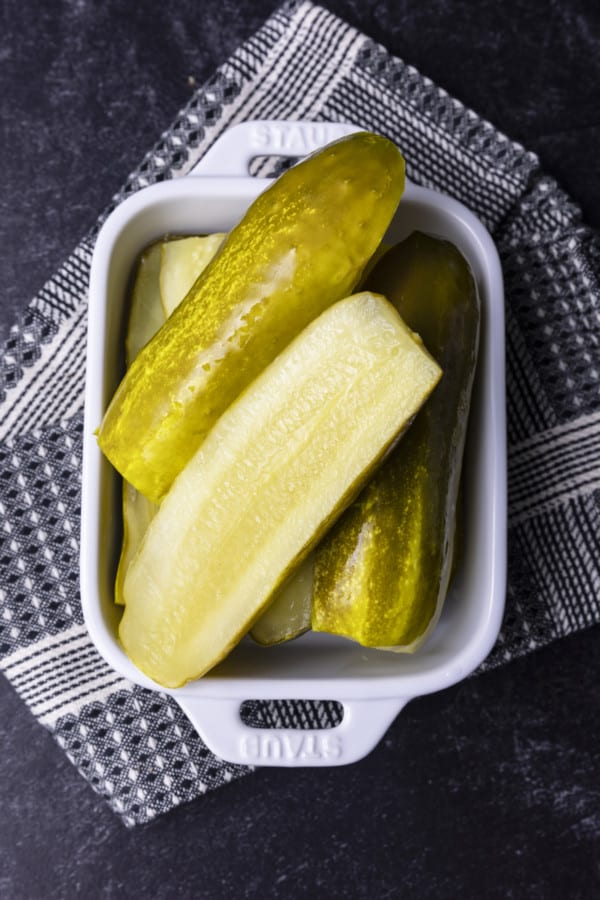
IMPORTANT NOTE: Because there is so much diversity in temperature, humidity, age of cucumbers, etc… involved in this recipe, please check your half sour pickles starting at 24 hours for doneness. If the pickles smell/taste pickley, move them to the refrigerator. Do not keep them on the counter longer than 4 days.
ANOTHER IMPORTANT NOTE: These pickles are not suitable for canning. They’re simply not acidic enough to can safely, and that is in addition to the fact that you’d ruin that perfectly crisp texture by introducing heat to the party.
What can I serve with these Homemade Claussen Knock-Off Pickles?
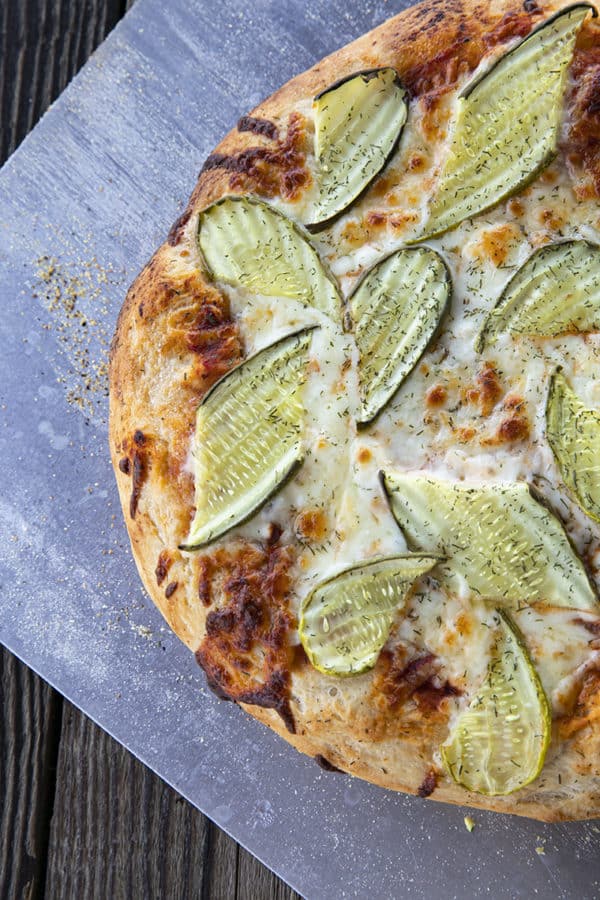
Start out by trying your half sour pickles in this Pickle de Gallo, Dill Pickle Dip, Dill Pickle Egg Salad, or Bagel Burgers with Dill Pickle Cream Cheese.
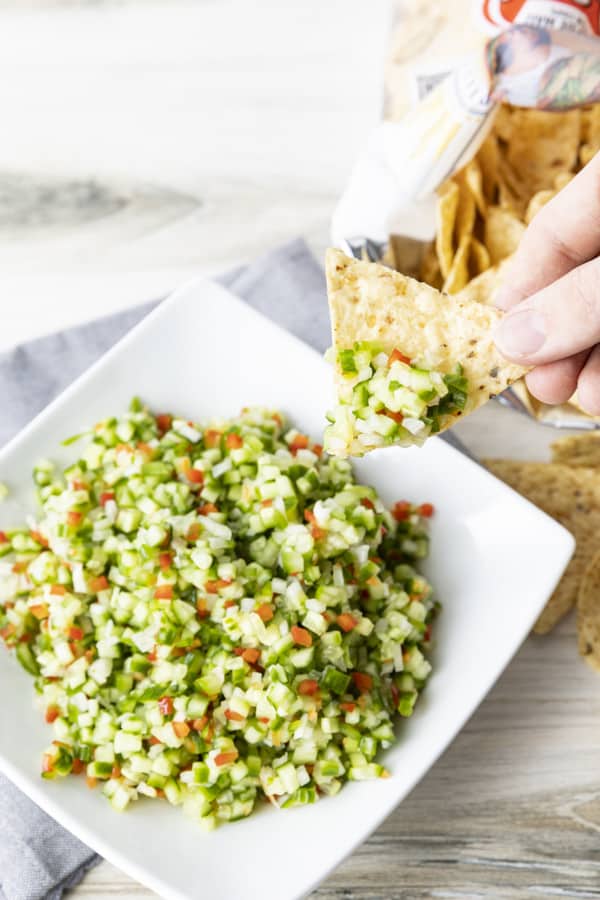
Even better, serve them on our Cheeseburger Salad or Pickle Pizza.
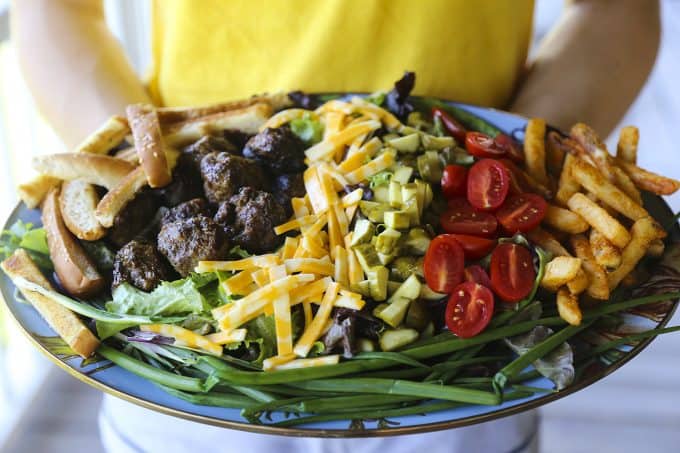
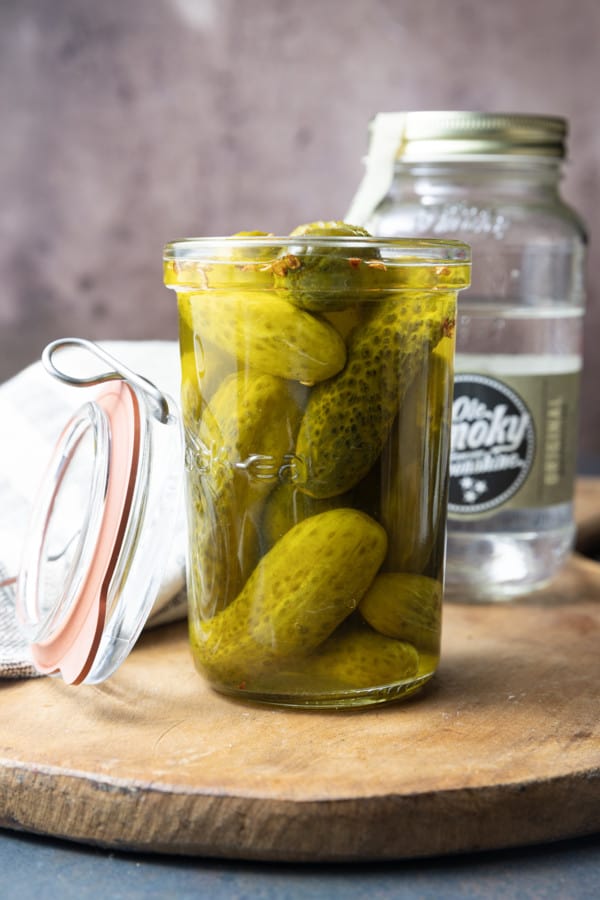
You can even take extra pickles (like that’s a thing!) and make these divine Moonshine Pickles. You’ve never had a better Bloody Mary than one made with homemade Moonshine Pickles!
Half Sour Pickle Recipe
What makes Claussen PIckles different from canned pickles? Claussen pickles, whether homemade or store bought, are a half sour pickle recipe.
That means they’re fermented instead of heat processed. That’s what gives them such great texture.
This half sour pickle recipe yields pickles that are crunchy to the point of making noise when you bite them, cold, and seriously garlicky. Canned, shelf-stable pickles can be chilled, maintain some crunch, and be as garlicky as you want them to be, but they are never, ever going to be the same thing because of science.
When you heat process a jar of pickles you are, in actuality, cooking it and a cooked pickle just plain can’t be as crunchy as an un-cooked half sour pickle recipe.
These homemade pickles keep well in the fridge for about six months, as long as they remain submerged in the brine. In our house, they never last that long because, as the saying goes, “A pickle a day keeps sad times away.”
They say that right? Someone must. If not, I’m going to start. It’s true, after all.
Claussen Pickles
Wash cucumbers but do not scrub them.
Trim 1/8-inch to 1/4-inch from the blossom end of each cucumber and slice in half lengthwise or into quarters, depending on how large your cucumbers are and how big you want them to be when they’re done.
Layer the dill heads or seed, garlic cloves, pickling spices and sliced cucumbers in a gallon jar (or large, wide-mouth, food-safe container). You can evenly divide the dill, garlic cloves, pickling spices, and cucumbers between several smaller jars if needed.
In a separate pitcher or bowl, stir together the remaining ingredients until the salt is dissolved.
Pour the brine over the cucumbers, taking care to make sure all of them are fully submerged. If needed, place a plate or mug or other non-reactive heavy item on the cucumbers to weigh them down and keep them under the brine!
Cover lightly with a lid just perched on top or secure a piece of cheesecloth over the jar with a rubber band to keep fruit flies away. Store any extra brine in a covered jar or pitcher in the refrigerator and use it to top off the brine if it starts to evaporate and expose the pickles to the air.
Leave out of direct sunlight on the counter for at least 24 hours, but up to 4 days, or until the cucumbers taste like pickles throughout.
Fix your lid onto your jar or container and chill thoroughly. These can be stored in the refrigerator for up to six months provided you keep them covered with brine.
NOTE: If at any point in the proceedings “fuzz” or “foam” develops on top of the brine, use a spoon to remove it. If there is “fuzz” attached to any of the cucumbers, remove the ones affected and be sure the others are still fully submerged.
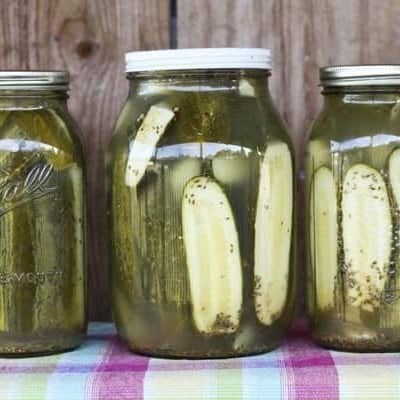
Homemade Claussen Knock-Off Pickles
Equipment
- 1 gallon jar or 4 quart jars or a large, food-safe container with a tight fitting lid
- 1 liquid measuring cup
- 1 large mixing bowl or pitcher
Ingredients
- 35 to 40 small to medium pickling cucumbers
- 1 gallon cold water
- 1 cup apple cider vinegar, preferably raw or white distilled vinegar
- 2/3 cup coarse canning or kosher salt Do NOT fine or use iodized salt!
- 4 cloves garlic or more to taste
- 4 heads fresh dill or 4 tablespoons dried dill seed not weed!
- 2 tablespoons mixed pickling spices
Instructions
- Wash cucumbers but do not scrub them.
- Trim 1/8-inch from the blossom end of each cucumber and slice in half lengthwise or into quarters, depending on how large your cucumbers are and how big you want them to be when they’re done.
- In a gallon jar (or large, wide-mouth, food-safe container) layer the dill heads or seed, garlic cloves, pickling spices and sliced cucumbers.
- In a separate pitcher or bowl, stir together the remaining ingredients until the salt is dissolved.
- Pour the brine over the cucumbers, taking care to make sure all of them are fully submerged. If needed, place a plate or mug or other non-reactive heavy item on the cucumbers to weigh them down and keep them under the brine!
- Cover lightly with a lid just perched on top or secure a piece of cheesecloth over the jar with a rubber band to keep fruit flies away.
- Leave out of direct sunlight on the counter for two to four days*, or until the cucumbers taste like pickles throughout.
- Fix your lid onto your jar or container and chill. These can be stored in the refrigerator for up to six months provided you keep them covered with brine.
- *If at any point in the proceedings “fuzz” or “foam” develops on top of the brine, use a spoon to remove it. If there is “fuzz” attached to any of the cucumbers, remove the ones affected and be sure the others are still fully submerged.
Notes
Nutrition
Nutritional information is an estimate and provided to you as a courtesy. You should calculate the nutritional information with the actual ingredients used in your recipe using your preferred nutrition calculator.
did you make this recipe?
Make sure to tag @foodiewithfam on Instagram and #hashtag it #foodiewithfamily so I can check it out!
Originally published July 22, 2011. Updated with FAQs and Troubleshooting and reposted August 2022.
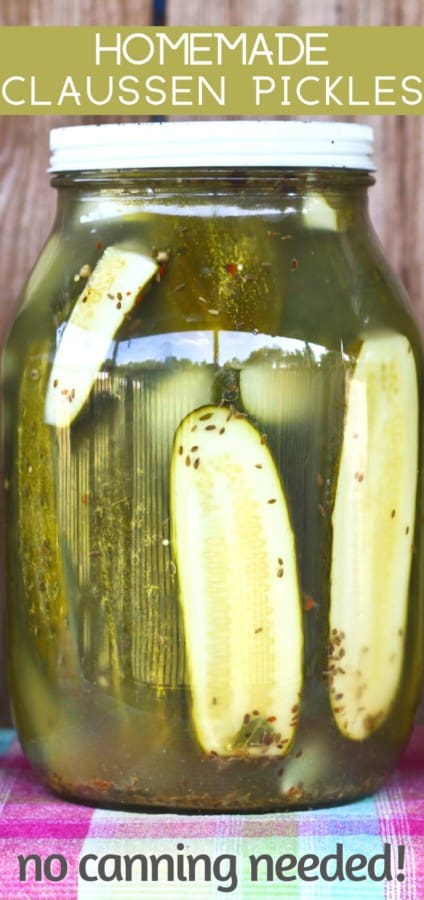
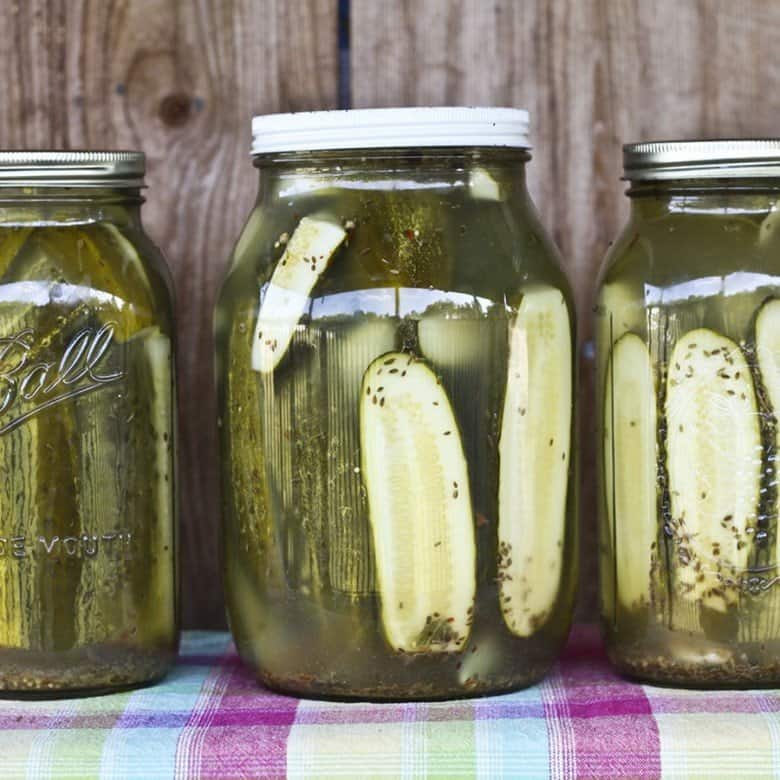
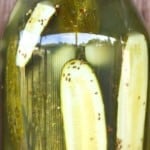



Reader's Thoughts...
Arie says
Hi
I’m interested in trying this recipe. If you don’t mind me asking, how critical is it to stick to this exact ratio for the brine? I am literally pickling 2 pickling cucumber nowhere close to 20lbs. And trying to adjust the serving size bar didn’t really help I’m not good at math 🙃 can you provide guidance or recommendations on adjusting the brine to pickles a much smaller amount ?
It’s only 2 of us so definitely don’t need/want to make alot.
Rebecca says
Hi Arie! The salt to vinegar to water ratio is pretty crucial in most pickles and I’d say it is here, too. I’d recommend you scale down to 1/4 of the original brine recipe (the spices don’t matter so much- so don’t sweat that.) If you don’t use all the brine, you can store it in a closed jar in the refrigerator for more pickles later. 🙂
Alissa says
Hello!
I accidentally combined the vinegar, dill, garlic, salt, pickling spices spices and water in the jar, mixed it up really well, and then added the pickles last into the pool of ingredients. Do you think this will be okay or should I start over?
Thank you!
Rebecca says
Hi Alissa- I think it ought to work out, but just keep an eye on it. 🙂
Keren says
I made these and loved them. I just used dill seeds and dill weed. I’m unsure of what constitutes one dill head. Can you further explain? Also, are the picking spices necessary? They gave a certain seasoning taste, and am wondering about leaving it out this season. Thanks!
Rebecca says
Hi Keren! You can certainly opt out of the pickling spices… they don’t lend anything to the party but a little background flavour. The dill head is a great concentrated dill flavour and kind of combines the essences of the seeds and 1 to 2 tablespoons of the seeds plus 1 teaspoon of dill weed is a pretty solid substitute for the fresh dill head.
Rebecca says
And thank you so much for being kind enough to rate the recipe and let me know you love it!
Ted says
I prefer Clausen whole, small to medium size pickles. Should I choose to pickle these size whole pickling cucumbers, would I need to adjust any of the ingredients and/or times?
Rebecca says
Hi Ted- You may want to give them a longer rest in the refrigerator before crunching into them, but otherwise, I think the same ratios/times will apply! Please let me know how it works out if you give it a go!
Mattie says
I’m going to try this! I love my pickles!
One thing though, I’m not exactly bright in the food preparation area. What do you mean by ‘layer the dill heads or seed, garlic cloves, pickling spices and sliced cucumbers’
Does that mean all the dill heads on the bottom, then garlic cloves on top of that, then spices, with all the cucumbers going on top?
Can’t wait to try it. Thanks.
Rebecca says
Hi there, Mattie!!! So what that means is that you’d do a layer of dill heads or seeds, a layer of garlic, a layer of pickling spices, and follow with a layer of sliced cukes!!! That was a great question!
Davey says
I reviewed over a year ago but thought I would once again tell the world how good these pickles are. I have made at least 20 batches and they always come out great. Tangy, crunchy, delicious. I honestly have no idea how people complain about the recipe or end up with moldy or mushy pickles, but if that is the result it is definitely something you are doing wrong. It’s not the recipe. Clean everything well, trim the ends off the cukes, measure the salt accurately, make sure the cukes are fully submerged in the brine, and keep them out of the light (I cover my jars with a dishtowel). Thanks again for a recipe I will always use.
Rebecca says
Oh my goodness. Thank you so much for weighing in on this and letting us all know you love them, Davey!! It’s much appreciated!
Shannon says
Does anyone know why my brine is cloudy after 3 days? Are the pickles still safe to eat?
Rebecca says
It’s absolutely fine to eat, Shannon! Cloudy brine is fermented (read: flavourful) brine!
Arvil Foster says
Tried this recipe. The worst, nastiest I’ve ever tried.
Janet says
Made these pickles today, now to wait til we can eat them which will seem like long wait. My only issue is why does recipe have you make a gallon of brine when it ends up you only need half that amount. Yes, I did use a gallon jar too…. Just wondering…
Rebecca says
Hi Janet! People pack jars differently and different cucumbers take up space in a jar differently. Additionally, having extra brine on hand in case you need to top off the jar isn’t a bad thing. As it’s just salt water, I always figure it’s better to have too much of it than to have to mix up another batch. 🙂
Bria says
I just finished a batch of these amazing pickles. This time around, after 2 days on the counter, half of the jars are cloudy and half are clear. Any idea why they look so different from one another? Are the safe to eat?
Rebecca says
That’s absolutely fine, Bria. I’m betting the cloudy jars are going to be ore flavourful. Cloudy brine is the sign of fermented foods and that’s a good thing!! I might be tempted to leave the clear ones out a little longer. 🙂
Bria says
I just finished a batch and they have been sitting on my counter for 2 days. Today, half of my Jara are cloudy and half look normal. Any idea why this happened and do you know if the pickels are still good?
Dave B says
Just used the recipe on 3 gallons of pickles!! I cant wait to try them.. My only concern is that I somewhat feel that the pickling spices will make them somewhat sweet? So I did half with them and a gallon without them.. thanks for the recipe
Rebecca says
Hi Dave- The pickling spices themselves contain no sugar, but just add a little depth of flavour to the overall pickles. 🙂
Sarah says
Made these exactly as stated and they’re so salty I have to throw them out. No one I’ve given them to has been able to stomach the salt, its all you can taste. So disappointed, I did 16lbs of cucumbers 🙁 Should have only done one batch first but went off the reviews.
Rebecca says
Hi Sarah- Let’s see if we can trouble shoot what went wrong for you. What type of salt did you use? And did you dissolve it in the water then pour the brine over the cucumbers?
Davey says
I’m guessing an error in measurement. I’ve made at least 20 batches of these pickles, and everyone in my family raves about them. Never heard a complaint that they are too salty.
Rebecca says
Thanks so much for weighing in on this, Davey! Much appreciated!!
Nori says
I just love this recipe! I make many batches through out the summer! BEST DILL PICKLE RECIPE!!!
Rebecca says
Thanks so much, Nori!! I appreciate you taking the time to let me know you love it!
Kristi says
‘Just want to add this info –> I just made these (cut into sandwich slices 1/4″/6mm thick), and they filled EIGHT qt jars (2 full gallons), with a couple of cups of brine leftover.
(I’m a seasoned pickle-canning-veteran, but this is my first year trying out refrigerator pickles….so I am VERY excited –and very thankful– for this recipe, blog, and all the commenting posters).
Pickle ON!
Rebecca says
Thanks for adding that info, Kristi! Happy Pickling! 🙂
Barbara says
Has anyone use Lemon Cucumbers or Armenian Cucumbers?
Rebecca says
I haven’t personally used lemon or Armenian cucumbers for this recipe, Barbara. If you give it a go, please let me know how it turns out!
Dan Keller says
sounds good
Rebecca says
Thanks!
Catherine Sydney says
Perfect recipe. It really feels good to find an idea blog post such as this, nice articles.
Kali says
With an overproduction of garden cucumbers this summer, I was thrilled to find your recipe! On day 3, we took a peek and found clearish slime on the top of many pickles and 1 mold spot. After reading your “fuzz” advice, I removed all cucumbers with the slime, which had a small part not fully submerged. We tasted a pickle and it has a slight odd taste, almost slightly cinnamon in nature. Should we throw out the whole batch as it could be contaminated?
Rebecca says
Hi Kali- Did your pickling spices have cinnamon bark in them?
Kristi says
Can you use distilled vinegar?
Rebecca says
Hi Kristi- I haven’t personally tried that, but I think if you scan through the comments section here you will likely find other folks who have!
davey says
I’ve made a bunch of batches using plain clear distilled vinegar, and they come out great.